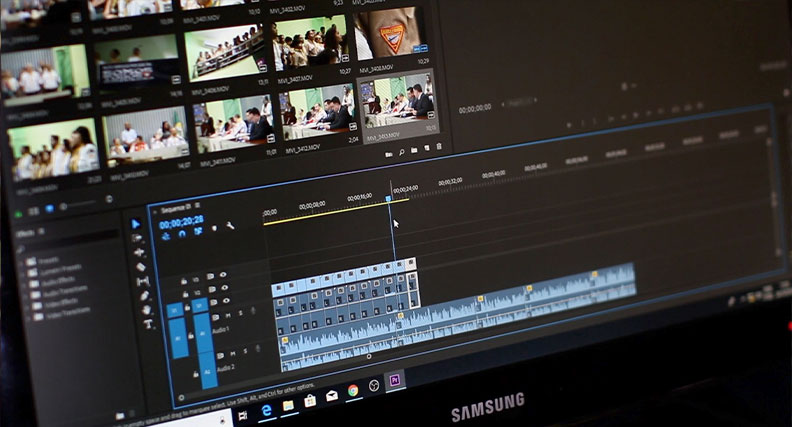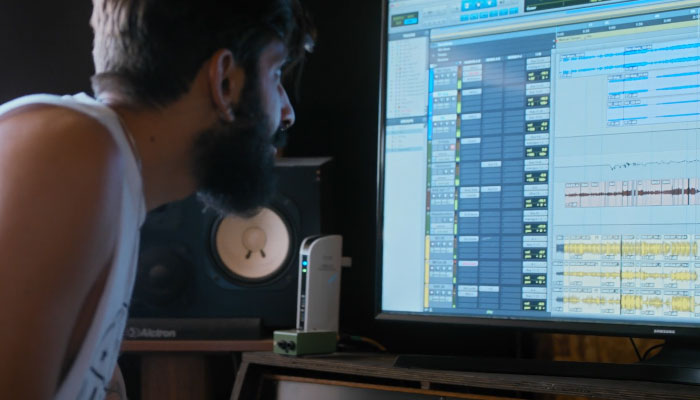
When setting out on your video editing journey, there is a lot of information to absorb. Understanding the fundamentals will stand you in good stead when it comes to moving on to more complex topics.
One of the most important things to understand is non-linear editing (NLE). Getting to grips with non linear video editing will help pretty much every project you will work on.
What is Non-Linear Editing?

Simply put, non linear video editing is the ability to edit footage you have shot in any order you want to. In most NLE software you will have a timeline — an area of the software that allows you to arrange the clips you have in any order, regardless of when they were shot. It's basically random access editing.
With non linear editing, it doesn’t matter if your clip is at the beginning, middle, or end of your project, nor does it matter whether was the first piece of footage you shot or the very last time you shouted, “Cut!” Non linear editing allows you to arrange what you have shot in the order you want to have it.
That’s what non linear means — linear means arranging things in a straight line, non linear means arrange any way you want.
Benefits of Non Linear Editing

The biggest benefit of non linear editing is the creativity it allows you to bring to the table. The creative process is no longer shackled to a particular timeline. Instead, you can arrange, shoot, and edit your footage in any order you want to.
That flexibility with video editing allows producers to do whatever they want with their footage. Not only can it be arranged in any order, but you can have your footage overlap, apply a host of different effects to it, play around with your soundtrack, build in chromakey and special effects… the list is endless.
It also makes the editing process much faster. Since you can access all of your footage at any time, it’s easy to skip between different parts of your project to see what’s working and what isn’t, move things about if you decide that a scene order isn’t correct, and provide a more efficient way of keeping oversight on your end project.
The other advantage of non linear editing is that it is non-destructive. That is to say, you never modify the original footage, only the footage which has been loaded into the non linear editor.
This means that if you make a mistake it’s easy to go back and fix because you always have the original footage available to you.
How to Use Non Linear Editing

Non linear editing is a digital-only method of editing. It requires your footage to be in a digital form, then loaded into video editing software. There are many different video editors on the market and which one you choose will depend on your hardware, your editing requirements, and your budget.
However, because digital footage is the norm these days, that means almost everyone’s footage will already be in a form that can be loaded into an NLE.
If you are working on a project that requires physical film or videotape, these will need to be converted into a digital format before you can use an NLE. The footage needs to be stored on to hard drives or other digital storage devices, such as a memory stick.
If you are converting footage from film or video, always go for the highest possible codec, and ideally, if you can get it in RAW format that would be best. This is a lossless format, so the quality of the original is preserved so the quality of your final project will be as good as it can be.
However, even if you are shooting digitally, using the highest quality codec is always advisable and as with film or video, if you can get your original footage in the RAW file format it will be of great advantage to you.
Main Difference Between Linear and Non Linear Editing?

The most fundamental difference between linear video editing and non linear video editing is that linear editing is analog and non linear editing is digital.
Linear editing involves having to run your film or video and then either physically cutting the film or videotape and then gluing it back together in order to make an edit or copying it to another medium such as a different roll of film or videotape.
The process is linear because it involves doing things in order — there is no way to move your video files around and because the footage is assembled one piece at a time, in order, this was called linear editing. Film editing is a laborious process for this reason.
While it’s true that a few of the early digital video editors maintained the linear approach, this fell away so fast that the analog/digital divide is a convenient way of thinking about it.
Linear editing involves only having one timeline — the final one. In non linear editing, you have multiple timelines. Unlike linear editing, there is no end to the ways that you can arrange your footage.
This doesn’t just affect the video, it also allows you to work with multiple auto tracks as well and makes the compiling of audio considerably simpler than it was using linear editing.
Balancing sound, controlling your mixes, adding voiceovers, foley, or special sound is all much easier and more convenient on non linear editing where the timeline allows you to just drag and drop whatever you want, wherever you want it.
Best Non Linear Editing Software
There are many different pieces of video editing software on the market, each of which has its own advantages and disadvantages. Here's a few of the best.
Adobe Premiere Pro (Windows, Mac, Linux)

Adobe is a titan when it comes to anything to do with visual editing and Adobe Premiere Pro is their non linear editor. Adobe Premiere Pro so well known that it’s an industry standard and has been the first choice for many video editors for a long time.
It’s a hugely powerful piece of software and includes pretty much everything you could ever need in terms of video post-production.
It supports a huge range of resolutions up to 8K, so video quality is always top-notch, and VR formats are supported alongside a host of transitions, tools, chromakey effects, and more.
There’s also options for audio editing, which while not as sophisticated as a standalone DAW (digital audio workstation) nevertheless adds to the package’s flexibility. And of course, it integrates perfectly with Adobe’s other software.
The tools follow the same design UI as Adobe’s other packages, so if you are familiar with Photoshop or other Adobe tools then picking up and using Premiere Pro will be easy. For newcomers, Adobe Premiere Pro can be a bit intimidating and might take a while to pick up.
Adobe Premiere Pro is also expensive compared to other packages and will benefit from having top-end hardware to run on — it’s powerful, but it needs the computing power to back this up. But if you have the resources and budget then Premiere Pro is as good an NLE as you can get.
DaVinci Resolve (Windows, Mac, Linux)

Not all non linear editing systems have to cost a ton and not all packages need to suffer from lowered features just because they don’t break the bank. DaVinci Resolve is a great example of just how much you can achieve without having to spend anything at all.
DaVinci Resolve might not have the price tag of Premiere Pro but its abundance of top-quality tools make it a great choice. Whether you are looking to dip your toe into video editing without any initial outlay or a professional who wants to enjoy a quality piece of software without spending a lot of money - it’s a great choice.
The color correction tools are second to none in DaVinci Resolve and it is a flexible piece of software that is very user-configurable. It supports 3D editing as well, and its motion tracking is surprisingly great for a free piece of software.
It’s user-friendly too, so it’s easier to learn than a heavyweight package like Premiere Pro and acts as a good introduction to the world of NLEs for newcomers.
Like Premiere Pro, DaVinci Resolve does require a fairly hefty computer to get the best out of but that’s true of almost all NLE’s. But if you’re looking for a great piece of software to begin your NLE journey, DaVinci Resolve is a fantastic choice.
Final Cut Pro (Mac)

Final Cut Pro is a really great NLE that comes with just one catch — you need a Mac to use it. However, if you have a Mac and are looking to get into video editing then it’s a perfect blend of hardware and software.
Apple does produce a free video editor, iMovie, but it’s pretty limited so if you want to get serious about video editing then Final Cut Pro is the way to go. While Final Cut Pro isn’t free, it only requires a one-time purchase so financially sits between Adobe’s ongoing monthly subscription and DaVinci Resolve, which is free.
It’s got a great range of tools that any professional can make use of and, thanks to Apple’s investment in the user journey, as easy to use as you can get with a complex piece of software like an NLE.
It’s also extremely fast when it comes to rendering, something which cannot be underestimated — there’s nothing more frustrating than finishing a project, and then waiting ages for your NLE to render the final results.
One thing that differentiates Final Cut Pro from other NLEs is the user of what Apple calls a “magnetic timeline”. What this means is that clips will adjust themselves automatically around other clips you move about. This can take a little getting used to for those more accustomed to a traditional timeline but once you do the advantages far outweigh the learning curve.
By definition, Final Cut Pro isn’t for everyone but if you have a Mac and want to get maximum use out of your hardware while working with a great NLE then you can’t go wrong with Final Cut Pro.
Conclusion

Whatever your needs are when it comes to video editing, there will be software out there to help you produce anything from a quick YouTube video to corporate training to a Hollywood blockbuster and plenty more besides.
Understanding non linear video editing software and what it is will help you on your journey and is one of the most important tools you have. Now all you have to do is use it!










